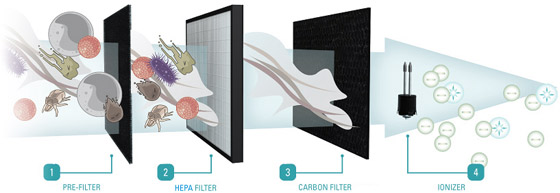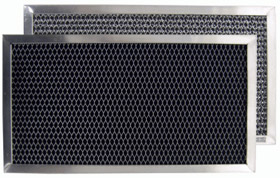Air purifiers are wonderful devices that benefit our health in numerous ways. From the less efficient to the more successful, they all seem to have one thing in common – complexity. Believe it or not air purifiers are not just a fan that can be turned on and off, making the air fresh and clean. The technology behind some air cleaners is so complex you need a manual to understand it, but since I don’t want to confuse you it’s probably best to leave it up to the scientists to do the hard work!
If you’ve ever had to purchase an air purifier or even thought about it, you’ve more than likely come across many different brands that have different features. Some have HEPA filters, some don’t. Some only feature activated carbon filters with no pre-filters at all.
I hope you’re still keeping up with me! To make things easier, please have a look at the image below to see how most air purifiers work:

What the most efficient units have in common are pre-filters as well as a powerful blend of two filters whose combination gives the ultimate results. Let’s take a deeper look into why pre-filters are good or bad, and how activated carbon filters contribute to the entire story.
Function of Pre-filters
Having pre-filters inbuilt into purifiers is a hefty advantage over cleaners that don’t. This is the first step in the filtration process where the pre-filters job is to capture large particles the main filter usually can’t, or particles that get stuck to it. It prevents debris getting into the main filter, and this is why pre-filters come in handy as an additional strength in filter technology.
Pre-filters can be vacuumed, washed, or replaced which helps to prolong the life span of your air cleaning unit. If they are washable, it’s a definite plus because you’re getting an efficient, cost saving unit. A pre-filter needs to be replaced at certain times because after using it and battling with harmful pollutants, it can get damaged and particles such as dust, fur, pollen and hair get stuck. If you want to replace or wash pre-filters it’s your choice, but if you really want to keep it safe you can always replace them when you feel the need for it.
Filter technology based on several levels of filtration like the ones utilizing pre-filters are usually more efficient at removing particles because they keep them in instead of releasing them back into the air. However, there are purifiers that don’t utilize pre-filter technology, so be aware of this when deciding which unit suits you best. Not only do pre-filters have their own purpose, they also prolong the life of the main filter, such as a HEPA filter. Additionally, some pre-filters keep the interior of the machine tidy as well which makes it easier to maintain your purifier.
Activated Carbon Filters
 Activated carbon filters are special in a few ways. They tend to capture more dirt and dust than standard filters. These pollutants are usually smaller and harder to catch. Nevertheless, they use chemically engineered carbon to do what they do best. Along with that, they also eliminate unpleasant odors in the room which comes quite in handy. If you’re a smoker, or the house is filled with unwanted smells of any kind, a carbon activated filter is the perfect “accessory” in an air purifier.
Activated carbon filters are special in a few ways. They tend to capture more dirt and dust than standard filters. These pollutants are usually smaller and harder to catch. Nevertheless, they use chemically engineered carbon to do what they do best. Along with that, they also eliminate unpleasant odors in the room which comes quite in handy. If you’re a smoker, or the house is filled with unwanted smells of any kind, a carbon activated filter is the perfect “accessory” in an air purifier.
Activated carbon is also called activated charcoal which goes through a process with oxygen to open up the pores between atoms. The main function of activated charcoal is to adsorb the odors or colored substances from liquids or gases. Do be aware though that carbon filters can’t be vacuumed or washed, they can only be replaced due to the nature of the job they perform.
There’s also the powerful combination of an activated carbon pre-filter. That’s double the precaution and filtration. Nothing gets through, dust, gases, or smells. Activated carbon filters are rarely used alone to clean the air, but as a helper they work wonders!
In the End
It all comes down to what you prefer. As far as the facts and functionality are concerned, we can’t deny that pre-filters play a significant role in the efficiency of an air purifier. The one piece of advice I will give you is to consider how large or small the particles are that you want to clear from the air. It all comes down to a personal decision, but the fact that both of these are useful can’t be denied.
